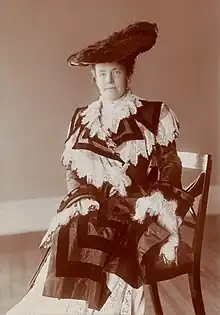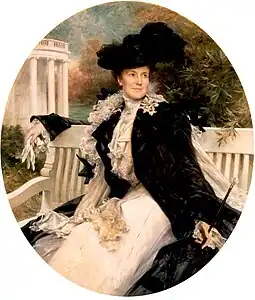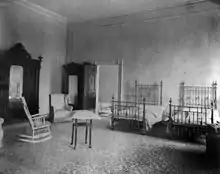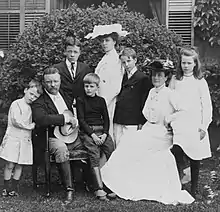Edith Roosevelt
Edith Kermit Roosevelt (née Carow; August 6, 1861 – September 30, 1948) was the second wife of President Theodore Roosevelt and the first lady of the United States from 1901 to 1909. She also was the second lady of the United States prior to that in 1901. Roosevelt was the first First Lady to employ a full-time, salaried social secretary. Her tenure resulted in the creation of an official staff and her formal dinners and ceremonial processions served to elevate the position of First Lady.
Edith Roosevelt | |
|---|---|
 Portrait by Frances Benjamin Johnston, c. 1903 | |
| First Lady of the United States | |
| In role September 14, 1901 – March 4, 1909 | |
| President | Theodore Roosevelt |
| Preceded by | Ida McKinley |
| Succeeded by | Helen Taft |
| Second Lady of the United States | |
| In role March 4, 1901 – September 14, 1901 | |
| Vice President | Theodore Roosevelt |
| Preceded by | Jennie Hobart |
| Succeeded by | Cornelia Fairbanks |
| First Lady of New York | |
| In role January 1, 1899 – December 31, 1900 | |
| Governor | Theodore Roosevelt |
| Preceded by | Lois Black |
| Succeeded by | Linda Odell |
| Personal details | |
| Born | Edith Kermit Carow August 6, 1861 Norwich, Connecticut, U.S. |
| Died | September 30, 1948 (aged 87) Oyster Bay, New York, U.S. |
| Resting place | Youngs Memorial Cemetery |
| Spouse | |
| Children | |
| Parent |
|
| Signature | |
Early life
Edith Kermit Carow was born August 6, 1861, in Norwich, Connecticut, to Charles Carow and Gertrude Elizabeth Tyler, the first of their two daughters.[1] Though her family was wealthy, her father was an unsuccessful businessman as well as a chronic gambler and an alcoholic, while her mother was a hypochondriac.[1][2] For much of her childhood, her family was forced to move in with various relatives.[3] She was troubled by her childhood, and she rarely spoke of her parents throughout her adult life.[4]
The Carows were close friends with their neighbors, the Roosevelts, and Edith's early schooling took place at the Roosevelt home, as well as etiquette instruction at the Dodsworth School.[2] Corinne Roosevelt was Edith's closest childhood friend, and Edith was often brought along with the Roosevelt children in their family activities.[1] At age four, she stood with the Roosevelts on their balcony to watch Abraham Lincoln's funeral procession.[5] Edith and Corinne formed their own literature club as children, the "Party of Renowned Eligibles", in which Edith served as club secretary each week over three years.[6] Edith also bonded with Corinne's brother, Theodore Roosevelt, over their mutual love of literature.[7]
The Carows moved uptown in 1871, where Edith attended Miss Comstock's School.[2] Here she developed a lifelong sense of strict religious morality.[8] She also took a more active interest in English literature, with a particular focus on the works of William Shakespeare, and she learned to speak fluent French.[1][2] After graduating from Miss Comstock's School in 1879, Edith participated in New York social life, attending balls and making social calls. She was unable to travel, as she had to stay home tending for her parents, who had both grown ill. Her father died from alcohol-related illness in 1883.[9]
Edith and Theodore grew closer as teenagers,[10] and they developed romantic feelings for one another.[11] They stayed in touch when Theodore went to Harvard University, but they had a falling out in August 1878.[12] The details surrounding this stage of their relationship are not known. Various reasons have been proposed by the respective families and by historians for their split, including a rejected proposal, Theodore Roosevelt Sr.'s disapproval of Charles Carow's alcoholism, a rumor that the Roosevelts were afflicted with scrofula, or clashing personalities between two people with strong tempers.[10][7] They revitalized their friendship in December 1879. Theodore was engaged with Alice Hathaway Lee at this time. This caused Edith grief, but she held a dinner in the couple's honor and then attended their wedding.[9] She maintained a close relationship with the Roosevelts over the following years, though she was cold toward Alice.[13]
After the deaths of Theodore's wife and his mother in February 1884, he moved west and distanced himself from his life in New York, and Edith did not see him for the following year.[14] He avoided Edith intentionally, worrying that he would betray his Alice by having feelings for Edith.[1] He returned to New York in September 1885,[15] where he encountered Edith by chance at his sister's house.[1] They were secretly engaged in November 1885, unwilling to disclose that Theodore was to rewed so soon after the death of his wife. After their engagement was set, they separated for eight months so Edith could help her mother and sister move to Europe while Theodore could settle his business affairs on the frontier.[15]
Marriage
Theodore Roosevelt's first wife, Alice Lee Roosevelt, died on February 14, 1884, aged 22, leaving behind their baby daughter also named Alice. Theodore and Edith rekindled their relationship in 1885.[16] They married in St George's, Hanover Square, London on December 2, 1886, when he was 28 and she was 25.[17] His best man was Cecil Spring Rice, later the British ambassador to the United States during World War I. Rice also maintained a close friendship with the couple for the rest of his life.[18] Theodore and Edith's engagement was announced in the New York Times. After their honeymoon, the couple lived at Sagamore Hill on Long Island, New York.[17] Roosevelt called his first daughter “Baby Lee” instead of “Alice” so as not to remind himself of the death of his first wife.[19]

Together, the couple raised Alice (Theodore's daughter from his previous marriage) and their own children: Theodore (1887), Kermit (1889), Ethel (1891), Archibald (1894), and Quentin (1897).[17]
In 1888, Theodore was appointed to the United States Civil Service Commission, where he served until 1895. While Edith supported her husband's decision to accept the position, she lamented that her third pregnancy would detain her at Sagamore Hill.[20] Kermit Roosevelt was born on October 10, 1889, and Edith moved to Washington with their children three months later.[20] During this period, Edith and Henry Adams became close friends.[20]
At Edith's insistence, Theodore did not run for mayor of New York in 1894, because she preferred their life in Washington, D.C., and his job as a U.S. Civil Service Commissioner.[17]
When Theodore became New York City police commissioner in 1895, they moved to New York City.[21] In 1897, Theodore was chosen as Assistant Secretary of the Navy and the family moved back to Washington.[21]
In 1898, Edith traveled by train to Tampa, Florida, to send her husband off to fight in the Spanish–American War.[16]
Upon his return from Cuba, Edith defied a quarantine to meet him in Montauk, New York, where she assisted veterans at the hospital. In October 1898, when Roosevelt was nominated for the governorship, she helped answer his mail, but stayed off the campaign trail.[17]
First Lady of New York
Edith Roosevelt enjoyed being First Lady of New York. During this time, she modernized the governor's mansion, joined a local woman's club, and continued to assist with her husband's correspondence.[17] While First Lady of the state, Edith began a custom that would continue in the White House—she held a bouquet of flowers in each hand. Edith found shaking a stranger's hand overly familiar and preferred to bow her head in greeting.[16]
Edith moved back to Washington when Roosevelt won the vice presidency in 1900.[17]
First Lady

After President William McKinley’s assassination, Theodore Roosevelt assumed the presidency, and his wife became the nation’s First Lady.[17]
With the country in mourning, the new First Lady could not do any entertaining. Instead, she focused on how to fit her large family into the White House. Edith eliminated the office of the housekeeper, performing the supervisory work herself.[20]
Edith Roosevelt also made a major institutional change when she hired Isabelle "Belle" Hagner as the first social secretary to serve a First Lady.[20][22] Hagner's initial assignment was to plan Alice Roosevelt's debut in 1902.[20] Soon, Edith began to rely on Hagner and authorized her to release photos of the First Family in hopes of avoiding unauthorized candids.[20]
Edith built on the First Lady's long history of entertaining visitors and made the titular office into that of the nation's hostess.[16] She expanded the number of social events held at the White House, ensured the parties of Cabinet wives would not outshine hers, and worked to make Washington the nation's cultural center.[16] The two most significant social events during Edith's tenure as first lady were the wedding of her stepdaughter and the society debut of her daughter, Ethel.[23]
Edith also organized the wives of the cabinet officers and tried to govern the moral conduct of Washington society through their guest lists.[23]

Edith is believed to have exerted subtle influence over her husband.[20] They met privately every day from 8 to 9 am.[20] The President's assistant, William Loeb, often helped sway the Chief Executive to Edith Roosevelt's way of thinking.[20] She read several newspapers per day and forwarded clippings she considered important to her husband.[16] In a 1933 article in the Boston Transcript, Isabelle Hagner reported that the legislation which created the National Portrait Gallery was passed because of Edith's influence.[20] Historians believe her most important historical contribution was acting as an informal liaison between Theodore Roosevelt and British diplomat Cecil Spring Rice, a link which gave the President unofficial information about the Russo-Japanese War.[24] As a result of negotiating the treaty which ended that conflict, President Roosevelt won the Nobel Peace Prize in 1906.[24]
The President and his wife became the first president and First Lady to travel abroad while in office when they made a trip to Panama.[25]
A perceptive aide described Edith Roosevelt as "always the gentle, high-bred hostess; smiling often at what went on about her, yet never critical of the ignorant and tolerant always of the little insincerities of political life."[26]
In 1905, Edith purchased Pine Knot, a cabin in rural Virginia, as a refuge for her husband.[17][23] At Pine Knot, the Secret Service guarded him without his knowledge.[24]
White House renovation

In 1902, Edith hired McKim, Mead & White to separate the living quarters from the offices, enlarge and modernize the public rooms, re-do the landscaping, and redecorate the interior.[17] Congress approved over half a million dollars for the renovation.[20] The new West Wing housed offices while the East Wing housed the president's family and guests.[20] The plumbing, lighting, and heating were upgraded.[20] Edith placed her office next door to her husband's so they could confer frequently.[23]
Edith took a historical view of the White House[24] and saw that the Green Room, Blue Room, and East Room were redecorated with period antiques.[23] McKim would have removed most of the existing furniture had Edith not intervened.[27] Edith's intervention ensured that the Victorian furniture seen in the Lincoln Bedroom today was retained.[27]
A larger dining room created a need for more china, so Edith ordered a Wedgwood service with the Great Seal of the United States for 120 people.[20][23] Interest in her own china fostered a curiosity about the services of previous First Ladies.[23] Edith completed the catalog of White House china that Caroline Scott Harrison commenced.[16] She added to the collection by purchasing missing items from antique shops. When she left the White House, there were pieces from twenty-five administrations.[16] She created a display of the china on the ground floor of the White House.[24] The White House china collection that Edith Roosevelt first exhibited is still on view today.[20]
Across from the White House china, Edith displayed portraits of former First Ladies. The once-scattered portraits were a hit with the public and guests to the White House could view the historical china and portraits as they waited to enter receptions.[20]
Edith called on former White House gardener Henry Pfister to help her design a colonial garden on the west side of the White House.[27] A similar garden was eventually placed on the east side of the White House.[27]
The public would first see the renovations to the White House during the 1903 New Year's Day reception.[23]
It was during Edith's tenure as First Lady that the White House became known as the White House. Previously, it had been known as the Executive Mansion.[24][28]
Relationship with her children

Roosevelt was a devoted mother who spent several hours a day with her children[16] and read to them daily.[29] She and her husband took an active role in their children's education and often corresponded with their children's teachers.[25]
Roosevelt longed for more children even after the birth of her fifth child, Quentin.[20] She suffered two miscarriages as First Lady.[20] She had a complicated relationship with her stepdaughter, Alice.[16] In later years, Alice expressed admiration for her stepmother's sense of humor and stated that they had similar literary tastes. In her autobiography Crowded Hours, Alice wrote of Edith, "That I was the child of another marriage was a simple fact and made a situation that had to be coped with, and Mother coped with it with a fairness and charm and intelligence which she has to a greater degree than almost any one else I know."[30]
Views on race
On October 16, 1901,[21] President Roosevelt invited African-American educator Booker T. Washington to dine with his family at the White House. Several other presidents had invited African-Americans to meetings at the White House, but never to a meal.[31] News of the dinner between a former slave and the president of the United States became a national sensation. The subject of inflammatory articles and cartoons, it shifted the national conversation around race at the time.[31] Some Republicans tried to spin the dinner into a lunch. As Deborah Davis explained on NPR, "they got hungry and they ordered a tray, and by the time they were finished, there was barely a sandwich on it. And that seemed to make the meal a little more palatable in the South."[31] The lunch story persisted for decades, until finally in the 1930s, a journalist from Baltimore's Afro-American newspaper asked Edith Roosevelt if it was lunch or dinner. Edith checked her calendar, and she said it was most definitely dinner.[16]
Among the responses to the dinner was a cartoon created by Maryland Democrats in which Edith sat between her husband and Booker.[16] The cartoon was widely reprinted.[16] According to Deborah Davis, this was the first time that a First Lady was lampooned in print.[16]
The dinner secured Washington's position as the leading black figure and spokesman in the United States.[32] Deborah Davis believes that Edith admired Booker T. Washington.[16] In a March 1901 letter, Theodore Roosevelt wrote to Booker, "Mrs. Roosevelt is as pleased as I am with your book."[16]
According to biographer Lewis Gould, careful reading of Edith's private correspondence reveals racial views that go beyond what he calls the genteel bigotry" of her time.[33] In 1902 and 1903 "Misses Turner and Miss Leech" performed at the Roosevelt White House. The women specialized in "Negro Songs" and Lewis Gould argued that by showcasing these performers, Edith entertained "guests with crude melodic stereotypes depicting an oppressed racial minority."[16]
Later life and death
.jpg.webp)
Edith's last decades included extensive travel to Europe, Asia, Africa, and South America. After leaving the White House, Theodore Roosevelt and Kermit went on a safari[16] while Edith took Ethel, Archie, and Quentin on an extended tour of Europe.[17]
The Smithsonian’s First Lady collection was created soon after the Roosevelts left the White House. When the museum's advocates asked her for a contribution, Edith said that she wasn't sure she could help: she often cut up dresses for the material after she wore them, and her inaugural gown was no exception. Her daughter later donated the remaining bottom half, and the Smithsonian refashioned the bodice using photographs.[34]
Edith did not advocate for her husband's 1912 third-party presidential race but supported him fully when it was underway formally. She tended him after the assassination attempt, consoled him when he lost the election, and accompanied him to Brazil to see him off as he explored the River of Doubt.[17] Both Roosevelts contributed to home-front activities during World War I.[17] For example, Edith Roosevelt was the honorary president of The Needlework Guild of America, one of the oldest nonprofits in the United States which provided new clothes to the poor, from 1917 to 1921.
Edith urged Republican women to vote after the 19th Amendment was passed.[17]
On January 6, 1919, her husband died of a pulmonary embolism in his sleep. He was 60 years old.
During the Great Depression, Edith campaigned briefly for Herbert Hoover to emphasize that the Democratic nominee, Franklin Roosevelt, was not her son.[17] Edith had disliked Eleanor since Eleanor's childhood and animosity had existed between the two women since the 1920s when Eleanor campaigned against Theodore Roosevelt Jr. during his run for governor of New York.[29]
Before her death, Edith destroyed almost all of her correspondence with her husband.[16] However, Edith was a prodigious letter writer and her letters survive in archives such as the Houghton Library.[16]
Edith died at Sagamore Hill on September 30, 1948, at the age of 87.[26] She is buried next to her husband at Youngs Memorial Cemetery in Oyster Bay.
Notes
- Schneider & Schneider 2010, p. 163.
- Cordery 1996, p. 294.
- Morris 1980, p. 20.
- Morris 1980, p. 15.
- Morris 1980, pp. 1–2.
- Morris 1980, p. 42.
- Gould 2013, p. 6.
- Morris 1980, p. 32.
- Cordery 1996, p. 297.
- Cordery 1996, p. 296.
- Morris 1980, p. 58.
- Forslund 2016, p. 299.
- Morris 1980, p. 65.
- Cordery 1996, pp. 297–298.
- Cordery 1996, p. 298.
- Sibley, Katherine A. S. (March 14, 2016). A Companion to First Ladies. John Wiley & Sons. ISBN 9781118732182.
- "TR Center – Edith Kermit Carow Roosevelt". www.theodorerooseveltcenter.org. Retrieved November 30, 2016.
- S. Gwynn (1929). The Letters and Friendships of Sir Cecil Spring Rice. Constable & Co Lt, London, p. 121.
- Lansford, Tom (2001). A "Bully" First Lady: Edith Kermit Roosevelt. Huntington, New York: Nova History Publications, Inc. pp. xiv. ISBN 1-59033-086-2.
- Gould, Lewis L. (February 4, 2014). American First Ladies: Their Lives and Their Legacy. Routledge. ISBN 9781135311551.
- Morris, Sylvia (February 19, 2009). Edith Kermit Roosevelt: Portrait of a First Lady. Random House Publishing Group. ISBN 9780307522771.
- Roosevelt, Priscilla, "Introduction: Memoirs of the First White House Social Secretary Isabella Hagner", White House Historical Association, Fall 2009 (White House History No. 26). Isabella as Hagner's formal given name, not Isabelle. Retrieved March 27, 2017.
- "Edith Roosevelt—Miller Center". millercenter.org. Archived from the original on December 4, 2016. Retrieved November 30, 2016.
- Hendricks, Nancy (October 13, 2015). America's First Ladies: A Historical Encyclopedia and Primary Document Collection of the Remarkable Women of the White House: A Historical Encyclopedia and Primary Document Collection of the Remarkable Women of the White House. ABC-CLIO. ISBN 9781610698832.
- Watson, Robert P. (February 1, 2012). Life in the White House: A Social History of the First Family and the President's House. SUNY Press. ISBN 9780791485071.
- "Edith Kermit Carow Roosevelt". whitehouse.gov. December 31, 2014. Retrieved November 30, 2016.
- Truman, Margaret (December 18, 2007). The President's House: 1800 to the Present The Secrets and History of the World's Most Famous Home. Random House Publishing Group. ISBN 9780307417312.
- "First Lady – Edith Roosevelt | C-SPAN First Ladies: Influence & Image". firstladies.c-span.org. Retrieved November 30, 2016.
- Harris, Bill; Ross, Laura (February 1, 2013). First Ladies Fact Book – Revised and Updated: The Childhoods, Courtships, Marriages, Campaigns, Accomplishments, and Legacies of Every First Lady from Martha Washington to Michelle Obama. Hachette Books. ISBN 9781603763134.
- Longworth, Alice Roosevelt (January 1, 1980). Crowded Hours. Arno Press. ISBN 9780405128462.
- "Teddy Roosevelt's 'Shocking' Dinner With Washington". NPR.org. Retrieved November 30, 2016.
- "Booker T. Washington – Theodore Roosevelt Inaugural National Historic Site". U.S. National Park Service. Retrieved November 30, 2016.
- "Edith Roosevelt's Views on Race". C-SPAN. Retrieved November 30, 2016.
- Steinmetz, Katy. "Belles of the Ball: An Insider's Look at Inaugural Gowns". Time. ISSN 0040-781X. Retrieved November 30, 2016.
References
- Cordery, Stacy A. (1996). "Edith Kermit (Carow) Roosevelt". In Gould, Lewis L. (ed.). American First Ladies: Their Lives and Their Legacy. Garland Publishing. pp. 294–320. ISBN 978-0-8153-1479-0.
- Forslund, Catherine (2016). "Edith Kermit Carow Roosevelt: The Victorian Modern First Lady". In Sibley, Katherine A. S. (ed.). A Companion to First Ladies. John Wiley & Sons. pp. 265–282. ISBN 978-1-118-73218-2.
- Gould, Lewis L. (2013). Edith Kermit Roosevelt: Creating the Modern First Lady. University Press of Kansas. ISBN 978-0-7006-2651-9.
- Morris, Sylvia (1980). Edith Kermit Roosevelt: Portrait of a First Lady. Coward, McCann & Geoghegan. ISBN 0-698-10994-5.
- Schneider, Dorothy; Schneider, Carl J. (2010). First Ladies: A Biographical Dictionary (3rd ed.). Facts on File. pp. 162–171. ISBN 978-1-4381-0815-5.
Further reading
| External video | |
|---|---|
- Boera, A. Richard. "The Edith Kermit Roosevelt Diaries". Theodore Roosevelt Association Journal. 12#2 (1986): 2–11.
- Caroli, Betty Boyd (1998). The Roosevelt women. New York, N.Y.: Basic Books. ISBN 0465071333. OCLC 39713794.
- Forslund, Catherine. "Edith Kermit Carow Roosevelt: The Victorian Modern First Lady". In A Companion to First Ladies (2016): 298–319.
- Lansford, Tom (2001). A "bully" first lady: Edith Kermit Roosevelt. Huntington, N.Y.: Nova Science Publishers. ISBN 1590330862. OCLC 50291248.